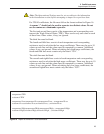
3.8, Methods Used for Calculating Coefficients, contains additional
information.
The Import button reads raw data in from an ASCII text file. The data must be
stored in the text file in the format required for calculating Polynomial, CVD,
or IPTS-68 coefficients. The import file format for Polynomial, CVD, or
IPTS-68 coefficients is discussed in Section 3.4.2.
The Export button saves the current raw data to an ASCII text file.
The Calculate button calculates the coefficients and displays the Coefficients
and Residuals dialog.
The Cancel button returns to the Platinum Probe Coefficients or Thermistor
Probe Coefficients dialog.
When calculating Polynomial coefficients for Platinum probes, the Select Cal
-
culation Scale dialog (Figure 14) is displayed.
Many readout instruments that accept Polynomial coefficients require that the
coefficients be calculated using Reference readings in a particular temperature
scale. This feature allows Reference readings to be used as entered on the Raw
Data dialog (with no conversion) or to be converted automatically to Kelvin by
TableWare. Prior to version 2.1, TableWare always calculated Polynomial coef
-
ficients after converting the Reference readings to Kelvin.
Note1: TableWare does not provide the option of converting Reference read
-
ings from °F to °C nor vice-versa. Also, if Reference readings were entered in
Kelvin, the Select Calculation Scale dialog will not appear and Polynomial co
-
efficients will automatically be calculated using Kelvin.
Note2: The accepted thermistor model is based upon the logarithmic resis
-
tance-temperature characteristic in terms of absolute temperature (Kelvin). The
accuracy of a model based upon °F or °C has not been tested. Therefore, Ta
-
bleWare always calculates polynomial coefficients for thermistor probes using
Kelvin. If Reference readings are entered in °F or °C, TableWare converts the
readings to their Kelvin equivalent values before the fit is computed.
9933 TableWare
User’s Guide
22
Figure 14 Select Calculation Scale dialog


















